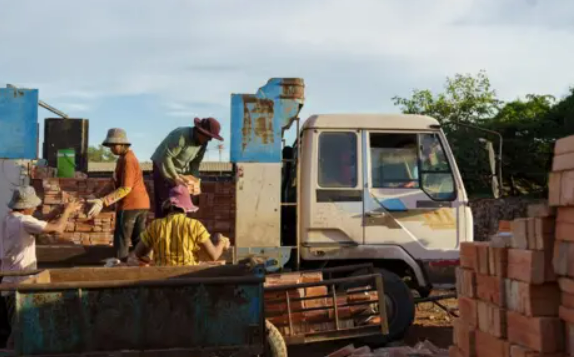Researchers have documented the health impact on brick kiln workers, who toil in some of the world’s hottest conditions
Chantrea drags an electric fan the size of a large door into the airless chamber where she works every day.
It is her only respite from the heat inside the brick kiln that looks more like a dimly lit tomb.
“It’s like working inside a burning prison,” the 47-year-old says as she stacks the dried bricks, which will be moved to a warehouse. “I have asked the owners to provide us with more fans. But they won’t because it will cost more money.”
The fan she does have slowly clunks as it starts, eventually whirring into action. It barely creates a breeze.
How hot is too hot to work? It is a question researchers have found the answer to here, in Cambodia’s brick kilns, where people toil in some of the hottest working conditions in the world, fueled in part by the scraps of fast fashion.
The BBC spoke to several workers who said they sweat so much through the day that it felt like they were in a hot bath. Fainting is common too, possibly because they become dehydrated. Their names have been changed because they fear reprisals from their employers.
In a first-of-its-kind study, researchers have tried to document how this sustained exposure to extreme heat is affecting workers’ health.
Special sensors recorded the core temperature of 30 workers at these kilns over a week and showed that they all had heat stress, or core temperatures of more than 38C. This can cause fatigue, dizziness, nausea and headaches.
A healthy body temperature usually ranges from 36.1C to 37.2C. Body temperature over 38C is symptomatic of a fever. Some workers had core temperatures of 40C, which can lead to heat stroke, resulting in convulsions, eventual loss of consciousness and even death, if not treated early.

One worker told researchers that he had suffered from heart failure due to the heat. But he eventually returned to work because this was the only way he knew to earn a living.
This is only made worse by a warming climate and Cambodia’s own weather – last May it hit a new high with 41.6C during the hottest year on record. As global temperatures soar, even a small increase could mean the difference between life and death for the tens of thousands of brick kiln workers across Asia.
“One of the big narratives that I hear again and again is that we’re all in this [climate change] together. But that’s absolutely not true. Some of us are a lot more in it than others,” said Laurie Parsons at Royal Holloway University, who authored the study.
Clothes carrying toxic traces
It’s a humid afternoon outside the kiln, on the outskirts of Cambodia’s capital, Phnom Penh. Inside, where Chantrea is stacking bricks, it is stifling.
But she is covered from head to toe in clothes that hang off her tiny frame – her only shield against the searing heat and dust. If the bricks are too hot, her skin blisters.
The kilns themselves are enclosed by brick walls and sealed. Workers stay outside and feed wood though a hatch to keep the fire hot enough, usually around 1500C to set the clay bricks. Once that happens, they stop fuelling the flames and when the heat seems less unbearable, they enter the chamber.
There is no data on the average temperature inside the kilns as it is hard for researchers to gain access. It’s also hard to know how many workers fall ill or worse because of the heat.
Injuries from falling bricks are not uncommon, according to Chantrea. And workers told the researchers from the UK that the bricks often burn them, even through the gloves.
Outside the kiln, Kosal, a father of two, scoops up a mix of fabric, plastic and rubber that he shoves into the hatch before shutting it quickly. Black smoke seeps through the cracks as children – his and other kiln workers’ – run past.

“I am used to the black smoke. I don’t notice it any more,” he says. “I have to keep these fires burning for 24 hours. My wife and I split the work between us.”
The children crawl over bags bulging with clothing offcuts – more fuel for the kiln from Cambodia’s $6bn garment industry.
But what may initially appear a solution to the unwanted scraps of the country’s 1,300 garment factories is actually hiding its own deadly secret.
According to a 2018 report – Blood Bricks – by UK academics at Royal Holloway, these scraps have traces of chlorine bleach, formaldehyde and ammonia, as well as heavy metals, PVC and resins used in the dyeing and printing processes. The report also found that brick factory workers reported regular migraines, nosebleeds and other illnesses.
Kosal’s three-year-old girl, her hair caked in dust, skips past a pile of Disney-labelled clothing. Most are flannel pyjamas embossed with images of Anna and Elsa from Frozen. They are made for children living in colder climates.
Most Western fashion labels have strict codes of conduct to stop this from happening. A Disney spokesperson told the BBC that the company was investigating the claim and that it “did not condone the conditions alleged in this situation”.
The BBC also found labels from Clarks shoes and H&M among others. Clarks called on the Cambodian ministry of environment to investigate and also invited other affected companies to join forces “in working together with the relevant authorities in Cambodia to eradicate this problem”.
H&M acknowledged that traceability is still an issue in Cambodia but said they did have their own waste management guidelines to ensure that fabric waste isn’t used as a fuel source by factories, or sent to a landfill.

Cambodia’s brick kilns have long been accused of unsafe and unfair working conditions – and they employ some of the world’s poorest people. Now, climate change is only exacerbating those inequalities, experts say.
“What we need to do is to consider how climate change impacts people through the lens of labour and inequality, and recognise that labour exploitation is a major factor in the worst impacts of climate change,” Mr Parsons said.
The heat trap
However toxic or difficult the job is, workers like Chantrea and Kosal can never leave. Victims of climate change, they are trapped in a cycle of heat.
The majority of those who work in Cambodia’s brick kilns were farmers. Chantrea used to grow rice. But sparse rainfall in recent years has made it difficult to manage a single harvest.
“We borrowed a lot of money after our crops failed. But when they kept failing, we ended up with a lot of debt,” she says.
Eventually she had no choice but to migrate to Phnom Penh in the hope of finding a job to repay the loans. More than two million of Cambodia’s 10 million adults have outstanding micro-loans, according to the Cambodian Microfinance Association. On average, they each owe $3,320 (£1,955).
This financial insecurity has supplied the vulnerable labour for brick kilns. Owners offer to pay off the loan but, in return, the worker is bonded to the kiln.
Often whole families are bonded to the kiln. The BBC saw children helping their parents in the kiln despite efforts by the Cambodian government to prevent child labour.

“If we leave, we are afraid of being arrested and imprisoned,” Chantrea says. “So we must struggle here. If they ask us to enter the fire, we will do even that just so we can earn more money for food and to pay off our debt.”
But the wages are too low for the debt to ever be repaid. Chantrea earns 10,000 Cambodian riel (£1.92; $2.45) for stacking around 500 bricks.
With this she has to pay for food, electricity and water. Her home is a tin shack on the edge of the kiln and she supports a boy she found alone on the street and adopted. When they are hungry, they forage together for snails.
“After several years, I have never paid the owner back,” Chantrea says. The debt, she adds, has only increased.
Cambodia’s kilns have fed the capital’s construction boom. It has drawn foreign investors, including the UK, which has invested one billion pounds, according to researchers from Royal Holloway University.
But as Phnom Penh reaches toward the sky, with tower after tower of air conditioned apartments, the city is leaving behind those who’ve helped to build it.

